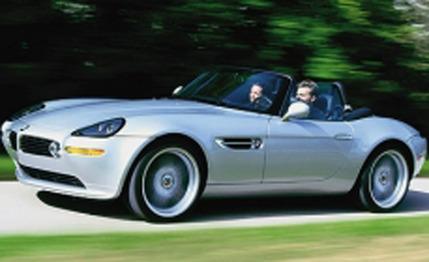
 First Drive Review
First Drive Review
The retro-style BMW Z8 has become the BMW Alpina Roadster V-8. The two obvious reactions are why and how?
Well, if you are sitting comfortably, we can explain. It starts, of course, with the Z8, introduced in 2000 as a modern interpretation of the classic 1956-59 BMW 507, with the company's first aluminum hull and the red-hot 394-hp, 4.9-liter V-8 engine from the mighty M5 sedan.
Burkard Bovensiepen's Alpina company has for more than 30 years produced the niche models that BMW itself does not want to make. Based in the Bavarian town of Buchloe, an hour or so from BMW's Munich headquarters, Alpina creates cars for connoisseurs. They are expensive and not necessarily more powerful or faster than standard BMWs, but they do offer combinations not available from the factory: a 305-hp 3-series sedan or wagon, whereas the M3 is only a coupe or convertible; a high-performance four-wheel-drive 3-series; and a 5-series with a 375-hp, 4.8-liter version of the regular BMW V-8 that, unlike in the M5, comes with an automatic transmission.
Relations between Alpina and BMW are up close and personal. Earlier this year, Burkard's son Andy—a successful racing driver in touring cars—gave up a senior engineering job at BMW to join the family firm. His father was comfortable making 800 cars a year, mostly for European customers, but Andy recognized that the cost of the engineering involved in these special models needed to be spread over a larger volume. He wanted to take Alpina to America.
An Alpina version of the Z8 with an automatic transmission instead of the six-speed manual seemed the ideal "door opener" for the U.S. Such a car was already being developed. Alpina had wanted to install its version of the BMW V-12, but it wouldn't fit; the engine's oil sump needed the same space as the rack-and-pinion steering system. The high-revving M5 motor was not suitable for an automatic transmission. But that 4.8-liter V-8 from the 5-series Alpina B10 V-8 S, with its attendant Alpina-specified five-speed ZF automatic, would fit right in.
And so the BMW Alpina Roadster V-8 was born. BMW of North America liked the idea and ordered 450 cars to be sold through its regular dealer network when the supply of Z8s comes to an end this spring. (Production of the regular Z8 for the U.S. market ended last November.) So the Alpina roadster becomes the final run of Z8s. Only 555 of the Alpinas will be built for worldwide consumption.
Production is a joint effort. The aluminum body structure, slightly modified to accommodate the automatic gearbox, is made by BMW at Dingolfing, alongside the body for der neue Rolls-Royce (see page 94). The engines are built in Buchloe (they have special pistons, rods, and ports that are polished and matched by hand) and join up with the transmission and body for final assembly in a dedicated shop in BMW's Munich facility. Then the almost-complete cars go back to Buchloe to be fitted with Alpina's special features and checked and approved for delivery.
Powertrain aside, Alpina makes few modifications to the Z8. "We regard it as a design masterpiece that should not be touched," says Andy Bovensiepen, adding that, unlike Alpina's other cars, top speed in the roadster is governed because the lack of spoilers and other aerodynamic aids means it might feel unstable beyond 160 mph.
Alpina motifs do appear inside. There is a numbered plaque between the seats where the Z8 symbol used to live, Alpina stitching on the soft leather seats, and blue-face dials for the centrally placed instruments. An extra display in a cowl directly in front of the driver shows the gear position; in addition to the console selector, manual changes can be made by pressing buttons behind the steering-wheel rim. Alpina calls the system Switch-tronic, and it requires a specially adapted version of the Z8's wire-spoke steering wheel.
The other identifying feature is the 20-inch wheels wearing ultra-low-profile Michelins. The Alpina's suspension uses softer shocks than the Z8's (the springs are unchanged), and it achieves remarkable ride comfort. The company's idea is to provide high performance in a more relaxed way than the M-cars—or the Z8.
Higher torque at lower revs not only suits the automatic gearbox but also gives the roadster effortless "stoplight" acceleration—which is not much slower than the manual Z8. Alpina claims 0 to 60 mph in 5.0 seconds; the last Z8 we tested did it in 4.6.
Our introductory drive in the BMW Alpina Roadster V-8 was on streaming wet roads with the factory-supplied hardtop in place. That didn't stop us from appreciating the engine sound, which is like the sweetest of traditional American V-8s, enjoying the Switch-tronic feature, and feeling that the more gentle suspension was beneficial.
In fact, some of us, who regard the Z8 more as a design icon than a serious sports car, reckon the Alpina Roadster V-8, with its easygoing power delivery and automatic transmission, is what this car should have been all along.